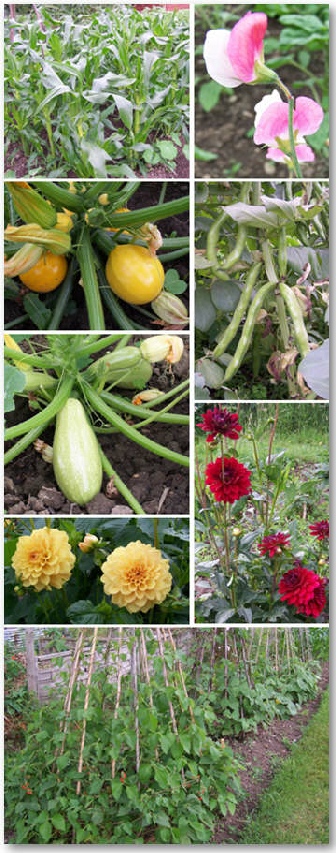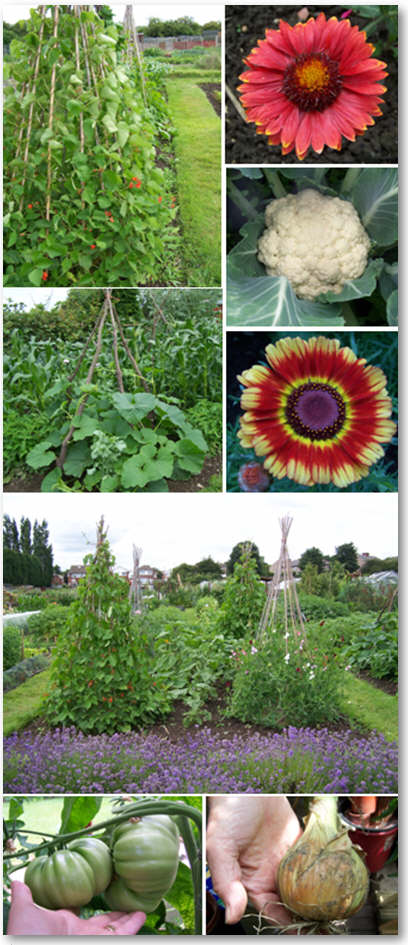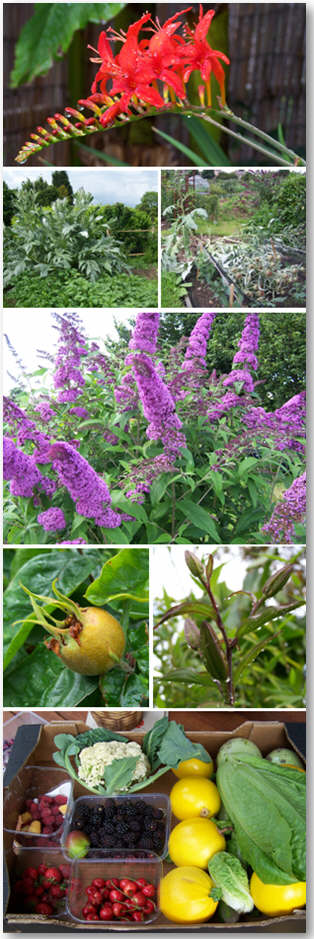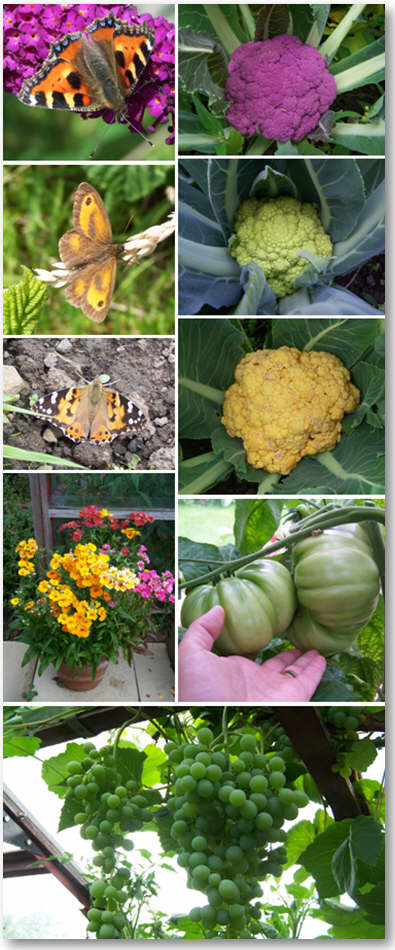


Our Plot at Green Lane Alloments Blog | Our Weather Blog | School Vegetable Patch Website | School Vegetable Patch Blog
© Our Plot on Green Lane Allotments -

5 July
It is as though the plot fairy has waved a magic wand this week, everything seems to have shifted a gear and catapulted itself into growth. With very little space left in which to plant we are now very much weeders and gatherers.
Although the strawberries are now coming to the end of their mass productive spell they have continued to provide a steady supply. We have also continued to collect redcurrants – a much steadier task which reduces fingers to a sticky mess.
Care is needed when picking the red dessert gooseberries as they put up more of a fight to hang on to their fruit. Another prickly customer is the tayberry, this was cut back severely last year to make room for our shed but is still managing to fruit. The new growth is being tied in regularly so that it doesn’t decide to wrap its prickly arms around us when we are sitting having a coffee. The blackberry that was also severely pruned is setting ample fruit for later in the year.
The blueberry bushes are now about three years old and have much more fruit than they have had previously but they seem to be taking their time to decide to ripen -
The apples are growing well – even the newly planted trees will provide a few fruits. I just need to check them over and remove any damaged fruit. No point making the tree use its strength on fruit that will be no good to eat or will attract the wasps. Plums and gages are also swelling.
Our cherry has a few fruits which we will need to net so that we can at least have a taster this year before the birds home in.
The kiwi alas has now lost all its flowers with no sign of any young fruitlets – oh well never mind maybe next year we will move on a stage.
Another grapevine – Boskoop Glory, a black variety has been planted to train along the eaves of the shed. It should be a really good position for it as the shed walls become really hot in the sunshine.
It’s not only the fruits that have moved on a pace this week. The brassicas were straining to burst through the netting and so the framework has been made higher. Not only were the plants in danger of being damaged but the leaves pushed up against the netting provided easy access for the white butterflies and pigeons.
The courgettes, marrows and cucumbers have also set off at full pelt. The courgette glut has begun so I have started to scour the internet for interesting recipes again! This year we have grown a yellow variety called Floridor that is producing masses of ball shaped fruits.
The tomatoes in both greenhouses are also producing fruit. The comfrey ‘still’ is working well and providing a steady drip of juice with which to feed the plot tomatoes etc. The bottom leaves of the tomato plants have been removed to try to avoid wetting the plant when watering. This is maybe a futile attempt to keep blight at bay but we lost all our tomato plants in the plot greenhouse last year to blight so anything is worth trying. The conditions this week were just what the blight spores are waiting for in order to mount an attack. We have, however realised one flaw in our choice of tomato varieties. One variety was a mixture of colours which we expected to be separately packaged – they weren’t. The mix has red, orange, yellow, black and green varieties. It is pot luck as to which colour plants we have grown but how will we know when they are ripe? We could be waiting for ever for a green variety to turn red!
The carrots are growing well – we pulled a couple and munched on them raw. The size was decent enough but having a plentiful supply of other things we decided to leave them a little longer.
The peas too seem to have grown taller than usual so we needed to raise the height of their supports. They are laden with peas, as we pass we keep giving the pods a gentle squeeze to test whether the peas are swelling but so far no luck. The mangetout, however are now ready and being enjoyed.
It’s becoming a really big decision as to which vegetables to have with dinner each day – no problem managing the five a day. We are now harvesting:
- Broccoli – Olympia
- Cabbage – Primo 2
- Winter Onions – Red Cross
- Lettuce – Balloon
- Mixed Salad leaves including young carrot and beetroot leaves
- Potatoes – Charlotte
- Courgettes – Floridor, Clarita & Zucchini
- Broad Beans – Witkiem Manita
- Turnip – Aramis
- Mangetout Peas – Dwarf Sugar
- We also harvested our winter shallots which were partially successful. One variety – Yellow Moon produced useable shallots, however there were few useable bulbs from the variety – Eschalote Grise with many having rotted.
The only thing planted this week was a tepee of climbing French beans Lingua Di Fuoco. The climbing beans already planted are now making a bid to reach the sky and beginning to flower.
The plot is also providing us with a second flush of cut flowers as the dahlias and sweet peas are beginning to flower. The centranthus has been cut back to try and cut down on the number of self sown seedlings that will need to be weeded out next year. The lavender is still looking great – the bees love it but have been robbed of a few sprigs for the house. The shrub roses are flowering well but some leaves have developed the dreaded black spots. At the moment these are few enough to be removed and taken away to dispose of but no doubt soon the disease will gain the upper hand and the bushes will lose many of their leaves. The flowers are worth putting up with that though!
It’s not only plants that have been eager to produce fruit. We have some rudd in our garden pond and this week the yearly frenzy took place. For a few days we could walk past the pond without fish eyes following our every move and begging for food. The fish dash around the pond in convoy either seeking a mate or a meal. Whilst some shed eggs the others gobble them up, however each year incredibly a number do survive to add to our rudd population.
A few seedlings and cuttings are being grown on in the garden greenhouse and cold frame. I took a few rosemary cuttings this week so that we can have a pot of rosemary handy by the greenhouse in the garden. Having a few herbs at home means that a few can be picked when the fancy takes us rather than having to be planned for and gathered from the plot.
In the garden too the plants are growing well. The mesembryanthemums seem to be growing too well and producing thick, lush shiny leaves instead of flowering.
Quite a few bushes and trees need cutting back and this week we made a start. Most need to be cut back to prevent them taking over the garden completely but the orange blossom was pruned back to improve the shape and flowering potential. Like some other flowering shrubs this needs to be done immediately after flowering so as not to sacrifice next year’s flowers.
The clematis – Princess Diana -
The astilbes that grew so well last year in the wet conditions are not really flourishing this year as the spots in which they are planted have been much drier this year so it looks as though they will need relocating. Maybe they are candidates for the position by the bird bath.

12 July 2009
To say that this week is July it has been a disappointment and visits to the plot have more or less been to harvest in between showers. We have had lots of heavy rain which has pounded the soil. On our clay soil once the sun, (the shiny thing that is sometimes seen in the sky), dries the surface it can crack and become hard and lumpy. With this in mind I have spent lots of time hoeing the surface and turning the soil in areas where we have walked when harvesting.
There is no doubt that crops are growing well and enjoying the conditions far more than we are. The weeds as usual are also thriving. Weeding is more a case of damage limitation than clearance. As soon as a patch is cleared, up pop all the weeds again, at the moment they very much have the upper hand.
We have had some gaps in what the weathermen refer to as showers when we have managed to get out and do some work on the plot. The rain stayed off long enough for the grass paths to be mown which always improves the look of the plot.
The most excitement this week was centred on the brassica beds. We have always had problems in getting any decent curds on our cauliflower plants. This week we noticed curds beginning to develop in quite a few of the caulis so the leaves have been bent over to stop the curds from yellowing.
The sweetcorn and squash are racing along now and looking very healthy. We now need to try and keep the squash plants under control as the long stems head off in all directions and tendrils will grab on to anything that offers potential support. The American Indians grew sweetcorn on the hills using a system called the seven sisters. They used the corn as a support for beans. The idea was that both gained benefit from this type of companion planting. The corn provided support and the beans released nitrogen. The third sister squash was grown underneath to provide ground cover which cut down the weeds and moisture loss. We did consider trying this method but were not confident that the variety of sweetcorn plants that we grow is sturdy enough to support climbing beans. As a half measure we are allowing some of the squash ‘arms’ to spread under the sweetcorn so it’s a sort of two sisters method. We also have some self sown nasturtiums muscling in on the act which are being left to provide a bit of ground cover.
Our fruit bounty has continued:
- Although our strawberry plants are now looking well past their best, they have still managed to provide us with a punnet of berries.
- We still haven’t picked all the redcurrants fortunately they seem to last for quite a long time on the bush and so we fit harvesting them between other things.
- We are still picking red gooseberries – these are really delicious.
- Unfortunately the blueberries are ripening only a few at a time. We tried to leave ripe berries on the plant to wait until there was a reasonable quantity for picking but we found that they ‘disappeared’ so we are now picking them as ready. We have found that if they are picked almost ripe and popped in a tray with ripe berries they turn colour overnight.
- Other fruit is continuing to grow well:
- The apples, plums and gages have held on to a good amount of fruit.
- The cherry has been netted to try and protect the few fruits that are reddening.
- The new alpine strawberry plants are flowering and last year’s plants that, until I set about them with a pair of shear, were looking very shabby are now looking as though they have been refreshed and are beginning to produce berries. It was a make or break action that appears to have worked. They have been given a feed of fish, blood and bone to try and help them along.
Vegetables harvested this week:
- The courgettes have now begun producing fruit with the yellow Floridor and light green Clarita being ahead of the green Zucchini. I have started searching the web for courgette recipes and have found one or two to try out but if anyone has any really delicious ideas to share then email me the recipe with a photo and it may end up posted on the website here.
- The plot continues to provide us with ample supplies for salads with a variety of lettuce and salad leaves. More radishes have been sown to provide a succession. The coloured varieties have grown well and add interest to salads. Radishes can be a bit boring so to try a different way of using radishes in a salad click here. The spring onions are very slow to mature, (we have only really had a few so far this year), and so I have abandoned the idea of succession sowing and sown another long row of Guardsman.
- Brassicas are doing well, we have harvested, broccoli – Olympia which has been so prolific that any heads that were starting to open have been discarded and cabbage – Primo 2 which are huge! This has been added to coleslaws as well as eaten as a cooked vegetable.
- Peas and beans are also flourishing and have provided harvests of:
- Broad beans – Witkiem Manita & Bunyards Exhibition
- Peas – Kelvedon Wonder
- Mangetouts – Dwarf Sugar
- The winter onions -
Troy & Red Cross - are huge this year and have now all been lifted. - We have also begun harvesting potatoes – Belle de Fontenay which are equally delicious eaten cold with a salad as when cooked.
Flowers are also being harvested to provide cut flowers for the house:
- Sweet peas – Perfume Delight & Kings Special Mixture are providing a natural air freshener for the bathroom. The flowers don’t last long but as they need continually picking in order the continue flower production, there are plenty to provide a fresh bunch every couple of days.
- The dahlias are also providing cut flowers.
The shrub roses have shown some signs of black spot and so I am trying to control this by removing affected leaves and taking them home to deposit in the wheelie bin.
In both greenhouses the tomatoes are growing well with some of the beefsteak varieties already having huge fruits.
Lavender and hebe cuttings in the garden greenhouse have rooted and been potted up and transferred to the cold frame.
The medlar in the garden looks set to produce more fruits this year and the John Downie crab apple also looks to have lots a fruit.
There is still lots to look forward to – fingers and toes firmly crossed.

19 July
This week everything on the plot and in the garden has definitely not been rosy! Drama has focused on the poor cardoons which until the strong winds decided to pay a visit were standing proud and tall. Two were completely flattened. If that wasn’t bad enough one faking plant has flattened some young cauliflower plants that were just recovering from pigeon attack. The bees have lost two of their favourite nectar bars! The tattered leaves of the banana plants are also courtesy of the windy weather.
The other plants that have been subject to a severe battering will hopefully recover sufficiently to produce a crop.
A highlight has been the harvesting of our first cauliflower of the season – a major success story for us. Some of our fellow plot holders manage to produce magnificent specimens but so far this achievement has eluded us. We now have purple, yellow, orange and green curds forming as well as the usual white but we am cautiously not counting our chickens (or cauliflowers) at this stage!
The weather has more or less kept us away from the plot although harvesting has continued. The week we have harvested:
- Broad beans – Bunyards Exhibition & Witkiem Manita
- Pea – Kelvedon Wonder
- Cabbage – Primo 2
- Potato – Belle de Fontenay
- Carrot – Early Nantes 2
- Broccoli – Olympia
- Cauliflower -
Snowball - The anticipated glut of courgettes has begun – the yellow Floridor is extremely prolific even by courgette standards.
- Mangetout – Dwarf Sugar which are now coming to an end
- Salad crops continue to keep us well provided except for the spring onions which are just so slow to come to maturity. Radish, salad leaf and lettuce seeds are being sown regularly to maintain supplies.
When cutting some dahlias I noticed some large, juicy blackberries had grown ready for picking. This made a surprise addition to our berry collection of strawberries, tayberries, gooseberries and blueberries. We have never had blackberries ready as early before. It’s a fruit that we normally associate with late summer or early autumn! The few cherries that our new cherry tree managed to produce provided another treat. This being the first fruiting we were unsure of how ripe they were but as some fruits began to split we decided it was now or never.
Seeds sown this week are:
- Spring Cabbage – Pixie
- Coriander – Confetti – this is a variety with leaves like carrot tops.
- Basil – Sweet Genovese
- Oregano – Greek
Seedling pricked out:
- Pansies Universal Mixed
- Foxgloves Excelsior Mixed
The intoxicating scent of the buddleias is now taking over from the declining lavenders as a favourite for butterflies and bees. They as much as us need more warmth and sunshine.

26 July
This week we have spent more time in the shed drinking coffee and avoiding downpours than working on the plot. Visits have been infrequent and mainly in order to harvest. Between showers we have managed to do a limited amount of tidying and planting.
Surprisingly the bees and butterflies seem to have been a little more resilient than we have been. Their reasons for visiting the plot, however, have echoed our own, i.e. to collect food.
This week we have harvested:
- Coloured cauliflowers – Kaleidoscope -
have been the novelty of the week. We have harvested purple and yellow curds. Unlike broccoli both keep their colour after cooking. - All the garlic – Solent Wight has been lifted. Unlike last year when most of the garlic rotted in the ground this year we have a good crop.
Our second variety of peas – Greenshaft – has also produced a good harvest. The pods are smaller than those of Kelvedon Wonder. Unlike the earlier peas which were in the main untouched some pods were home to pea moth caterpillars. Earlier varieties do tend to avoid this type of infestation as although adult pea moths emerge from early June onwards, the female pea moth is most active in July. No doubt our second sowing of Kelvedon Wonder will also host pea moth grubs.
The last of the mangetouts have been picked.
Potatoes are being dug as required although quite a few of our potatoes are beginning to yellow which we are concerned is indicating the onset of blight. Anya seems particularly affected. The Sarpo Mira potatoes show absolutely no signs of yellowing and are still growing well.
The courgettes as usual are producing masses of fruit – on site there is now much competition to find someone who isn’t growing courgettes and will be happy to take some off growers’ hands.
The dwarf French beans – Delinel -
Our berry harvest continues. The tayberries and gooseberries are coming to an end leaving the blackberries and blueberries to take over. One blueberry thief has been identified as a female blackberry. She jumps up alongside the plants grabbing out at any almost ripened berries. If we are anywhere near when she pays a visit to check out the bushes, she sits on the top of the greenhouse complaining!
We have also managed a few sticks of – Timperly Early – rhubarb which seems to be sending up a second flush of stems. It made a lovely crumble!
The dahlias and sweet peas are now flowering well meaning we have a ready supply of cut flowers. The sunflowers too are beginning to bloom.
In the garden greenhouse the grapes are still not quite ready to pick and the giant tomatoes are just growing even bigger
